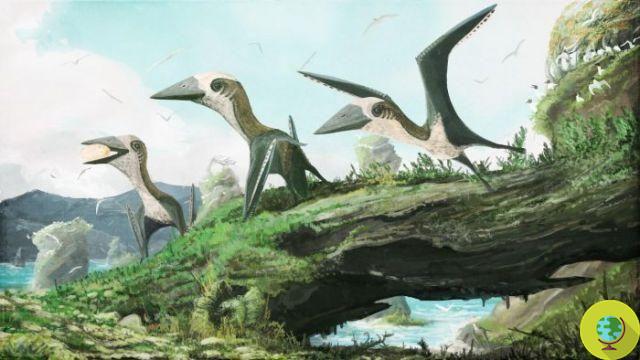
An important find, as many as 200 eggs and 16 pterosaur embryos have been unearthed by a team of Chinese scientists. The exceptional discovery could solve one of the mysteries that paleontologists are still wondering about. Were pterosaurs able to fly immediately after their birth?
He is about to end up run over, his mother saves him
An important find, as many as 200 eggs and 16 pterosaur embryos have been unearthed by a team of Chinese scientists. The exceptional discovery could solve one of the mysteries that paleontologists are still wondering about. Were pterosaurs able to fly immediately after their birth?
These winged reptiles soon after hatched their eggs could not take flight. The research was conducted by a team of Chinese scientists on over 200 eggs and 16 embryos of the Hamipterus pterosaur, through the first computed tomography scans and sheds light on the flight abilities of these dinosaur cousins.
So far few pterosaur fossils have been preserved due to the fragility of their very thin bones. Even rarer are the fossils of young specimens, eggs and embryos. This made it difficult to understand how the different species grew and evolved.
Il first pterosaur embryo was found in China in 2004, but the egg and embryo managed to give very little information as they were severely damaged and crushed. The first three-dimensionally preserved pterosaur egg comes from Argentina from an animal called Pterodaustro.
But in 2014, Chinese paleontologists discovered a real treasure: hundreds of bones and eggs of the pterosaur Hamipterus, who lived in the early Cretaceous period, about 120 million years ago. Surprisingly, the site where the fossils were found contained eight separate geological layers, four of which also held eggs.
The team of Chinese and Brazilian paleontologists led by Xiaolin Wang has examined these eggs in more detail, using computed tomography and studying the microstructures of the bone to understand how these ancient creatures grew. With i ray X they were able to see inside the eggs and embryos without damaging them in the least.
Paleontologists in the past had already found other sites with many pterosaur bones in them, assuming they were social animals. But the new discovery is the first to confirm that nests were also common.
Unlike other embryos of pterosauro originating from China or Argentina, there was little material from the skull, only a lower jaw. The wing and leg bones showed signs of ossification, the process of depositing minerals to form bones, but the extremities were not fully formed or mineralized. This suggests that the muscles were not well developed in the embryos and that the little ones were unable to fly immediately after birth.
READ also:
- DINOSAUR EGGS FOUND IN CHINA (VIDEO)
- THE BEST PLACES IN THE WORLD TO WALK WITH DINOSAURS
- FEATHERED TAIL OF DINOSAUR HIDDEN IN AMBER: THE HISTORICAL DISCOVERY (PHOTO)
The research was published on Science.
Francesca Mancuso


























